
Note: This page is an archive, retained for the convenience of anyone who has bookmarked it in the past. The updated, corrected, and expanded version is now our "Mountain Music, Bluegrass, and Autoharps" article at HarpersGuild.com
| Please Read: How to Help Our Site at No Cost to You - Some of our articles contain recommendations for products we like and vendors we personally trust. Some of those vendors may pay us a very small commission if you click on a link and buy their products. This costs you nothing at all and helps offset the costs of what we do. So if we point you to something you decide to buy later, please make certain you come back through our site and click on the link directly. Thanks. |
| This Site is a Cookie-Free Zone - Except for discussion forums that you have to expressly register for, none of our pages use cookies of any kind. Some of the vendors we link to do, but that won't affect you unless you click on a link to their pages. Your continued use of this page indicates that you agree to our policy. For details, click here. |



|
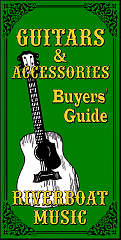
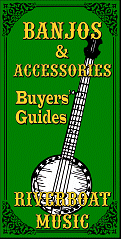
Mountain Music, Bluegrass, and Autoharps

I started this article because in the middle of a bunch of autoharp related projects, I kept running across Oscar Schmidt autoharps that were advertised as "ideal for Bluegrass." But most of them had exactly the same chords as their entry-level autoharps; and therein lies the problem - standard autoharps (whether from Oscar Schmidt or Chromaharp) don't have all the chords you would need to play every song in a Bluegrass set.
They DO have chords you'll never use (like Ab and Bb7). This makes them, frankly, less "Bluegrass-friendly" than they are, say, "Polka-friendly."
The photo to the right shows one version of the Oscar Schmidt "Appalachian," model OS-45C. Oscar Schmidt recommended it "for Bluegrass" because of its "hand-crafted" appearance, but - musically - it's no more useful for Bluegrass than Oscar Schmidt's entry-level OS-21C.
To connect the dots between any autoharp and Bluegrass, though, it's necessary to take a step back and look at the history of the instrumentation typically used by Bluegrass bands. And there is a long and storied ancestry.
 What is a "String Band"?
What is a "String Band"?
Any definition I give will leave some folks dissatisfied, but it's worth knowing that Bluegrass didn't come out of nowhere. Bands using guitars, banjos, fiddles, mandolins, and similar instruments were around nearly a century before Bluegrass.
For literally hundreds of years, folks who lived in rural areas of North America have made their own entertainment by playing songs everybody in the community knew on stringed instruments that could be hand-made, or, later - ordered from mail order catalogs. Fiddles, guitars, banjos, and mandolins were most common, but slide guitars sometimes showed up as well. ("Jug" and washtub bases were probably less common than most folks have been led to believe. At least they almost never show up in the hundreds of old string band photographs that have survived to this day.)
Historical string bands could play for hours at barn dances, etc., often belting out songs with dozens of interchangeable verses like "Old Joe Clark," "Old Dan Tucker," "Boil that Cabbage Down," and "Shady Grove."
And, in case you wondered, I have no idea who the fellows in the photo to the right are. But I have tracked down lots of other photos of similar unnamed string ensembles, so I'm not making this stuff up.
String-Band Friendly Keys
Although most experienced string band musicians could play songs in any key, banjo pickers of that time - left to their own resources - preferred to play in C or G. Guitarists tended to prefer playing the key of C, G, D, or A, sometimes straying into F or E. I have been told that some old-time fiddlers preferred to keep songs in the key of A as much as possible, though that was hardly universal, and is not currently true in most genres that still use string-band instrumentation.
Slide guitar and mandolin could be a little more flexible, but the point is that most string bands led by guitarists or banjo players tended to play in keys like C, G, D, and A, tending toward "sharp" end of the key spectrum.
Since we're supposed to be talking about autoharps, I'll point out that autoharps didn't make a big splash until the late 1800s, and very few played many of the chords needed to play in sharp keys. A few autoharps did find their way into string bands, but they were not the kind of autoharps people play today - more on that later.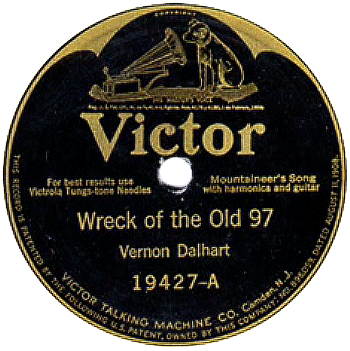
Radio Influence and "Mountain Music"
By the early 1900s, radio was reaching even to the most distant populations, and popular songs began to figure more strongly in the music of the string bands. And, conversely, the type of music favored by string bands in out-of-the-way places began to find its way to the airwaves.In 1924, Vernon Dalhart recorded an old folk song, "The Wreck of the Old 97." Today, that recording is often called the first million-selling "Country" recording. But there was no such genre in 1924. Instead, music that sounded like it had come straight out of Appalachia was often called "Mountain Music" or some such. On the label of Dalhart's recording, it is called a "Mountaineer's Song."
The "First Family" of Mountain Music
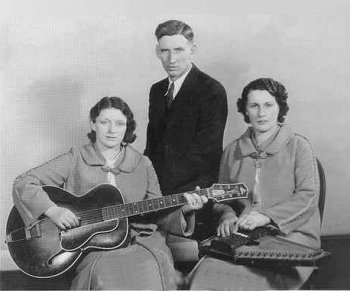 Encouraged by the success of that recording and a few that followed, A.P. Carter dragged his wife and her sister into a recording studio in 1927. A.P. wrote songs like "Keep on the Sunny Side," which showed the influence of popular music structures at the time (like the inner rhyme on the third verse of the chorus). But he also tracked down many folk songs that had long been sung in the hills and brought them to light.
Encouraged by the success of that recording and a few that followed, A.P. Carter dragged his wife and her sister into a recording studio in 1927. A.P. wrote songs like "Keep on the Sunny Side," which showed the influence of popular music structures at the time (like the inner rhyme on the third verse of the chorus). But he also tracked down many folk songs that had long been sung in the hills and brought them to light.
The Carter Family was one of the few string bands to use autoharps consistently, but - again - they weren't the kind of autoharps sold in stores today.
When they started recording, Maybelle usually played guitar, and Sarah usually played autoharp. But what kind of Autoharp did she play?
By the time the Carter Family started playing "out," many autoharp designs had come and gone, but a few of the earliest designs were still available. To play most early Carter Family songs in the key of C, you need three chords, C, F, and G (or G7, which is a G chord with an F added).
All of the early autoharps Sara had access to would play C, F, and G7 chords, but the earliest photos we have show her playing a 7- or 8-chord autoharp, possibly a model 2 7/8, which would play Bb, F, C, C7, G7, Am, and Dm chords. So songs in F were possible, too. Songs in "string-band-friendly" keys like G, D, A, and E were not.
That said, autoharps didn't catch on among many other string bands of the time. Bands with fiddles, banjos, and mandolins had a greater tendancy to play in keys like G, D, and A.
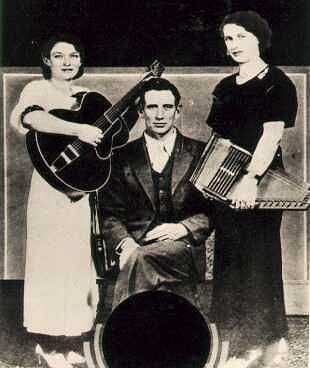 Sarah's First 'Iconic' Autoharp
Sarah's First 'Iconic' Autoharp
Whatever she started out on, we know that Sarah eventually played a Model 72 7/8, an eight-chord autoharp similar to the one shown below left. We know that because at least one of her Model 72 7/8 autoharps has been displayed in the Country Music Hall of Fame and Museum.

The Model 72 7/8 could play the following chords: Bb, F, C, C7, G7, A7, Gm, and Dm. So, even with the extra chords, you could still only play three-chord songs in F and C.
Of course few string bands play many songs in F. But Maybelle never minded playing guitar in C, and she could play just fine in F. So the 7- and 8- chord autoharps worked out just fine for at least some of the Carter Family songs.
The Rumored "Shifter" Autoharp"
One expert told me that Sara Carter may have owned a Model 6 or something like it at some point. These were equipped with shifters that allowed a 6-bar autoharp to play 16 or more chords, supporting the keys of G and D. In the spirit of a natural-born fact-checker, I went on a hunt for proof of any kind. I even tracked a Model 6 down and bought it. But when it came to linking any shifter autoharp to Sarah Carter, I came up cold.
I'm leaving this section in here just in case any readers come across proof that Sarah ever got ahold of one of these. Also, to provide a link to the article I wrote while I was researching them.
For more information on "shifter" autoharps, click here.
Graduating to 12 Chords
 The 12-chord Model 73 was introduced about 1898. But for the first 17+ years, it existed alongside "shifter" models with more chords, like the Model 6. In fact, when the Carter Family started recording, the Model 73 had been out of production for a while. Apparently nobody imagined that it would eventually become Oscar Schmidt's "flagship" model for decades to come.
The 12-chord Model 73 was introduced about 1898. But for the first 17+ years, it existed alongside "shifter" models with more chords, like the Model 6. In fact, when the Carter Family started recording, the Model 73 had been out of production for a while. Apparently nobody imagined that it would eventually become Oscar Schmidt's "flagship" model for decades to come.
By the time Oscar Schmidt revived the Model 73 in 1932, the "shifter" autoharps had been discontinued for about 16 years. Consequently, the Model 73 had the honor of having more chords than any other autoharp currently in production. It became the "standard" Oscar Schmidt autoharp for the next 30+ years.
For string bands working around a single microphone, as was standard in recording studios and on stages of that day, the Model 73 had one distinct advantage over some of the older models - you could play it standing up by holding it across your chest and reaching around it with your left hand to press the chord buttons. You could and even walk around with it to get closer to the microphone when it was time for your solo. (Another string band player, Cecil Nutt, is said to have originated that method of playing.)
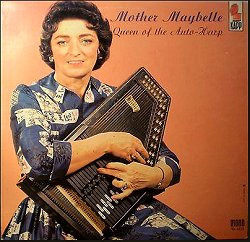 When Sarah upgraded to a Model 73, she continued to play autoharp in her lap or on a stand. But when Maybelle started playing a Model 73 consistently, she held it in what is now called the "upright" position. That is, she held it across her chest and reached her left hand around it to push the chord bars.
When Sarah upgraded to a Model 73, she continued to play autoharp in her lap or on a stand. But when Maybelle started playing a Model 73 consistently, she held it in what is now called the "upright" position. That is, she held it across her chest and reached her left hand around it to push the chord bars.
Unlike the Model 72 7/8, the Model 73 provided the ability to play songs in G. In addition, many minor key songs were possible.
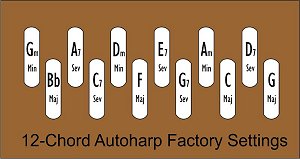 The chord bar layout of the Model 73 (and almost all other 12-chord harps) is shown to the left.
The chord bar layout of the Model 73 (and almost all other 12-chord harps) is shown to the left.
The Model 73 did have D7 and A7 chord. So if you reconfigured those two chord bars to D and A respectively, you could have had an instrument that would play 3-chord songs in F, C, G, D, and A - and it would have been a very useful instrument for string bands. But nobody did such things in those days. In fact, after the Model 6 went away, you couldn't get a commercially-built autoharp that could play 3-chord songs in the key of D until the 1960s.
If the Oscar Schmidt company had paid more attention to what autoharps were actually being used for after the Carter Family and their contemporaries put string bands on the radio, they might have sold a lot more instruments. Instead, the Model 73 went without anything like a meaningful update for nearly seventy years.
Autoharp Upheaval
In the 1960s, three things caused a rapid redevelopment of Oscar Schmidt autoharp.- The Folk Revival and the continuous rise of Country Music and related forms caused a demand for autoharps that could play in the key of D, a favorite of guitar players.
- The folks who were playing autoharp were nearly all playing it in upright position, which was awkward with a Model 73.
- The Chromaharp company started gearing up to make autoharps that were more ergonomic than Oscar Schmidt's designs.
Frankly, when your flagship product (the Model 73) hasn't been reengineered for nearly 70 years, you may have a problem.
Fifteen-Chord Autoharps
 The first adjustment, in 1964 was to add three more chord bars to the autoharp, D, F7, and Eb, as shown to the right. That did add the ability to play most songs in Bb. And, technically, to play 3-chord songs in D, if your left hand was big enough for you to alternate between the D button and the G button.
The first adjustment, in 1964 was to add three more chord bars to the autoharp, D, F7, and Eb, as shown to the right. That did add the ability to play most songs in Bb. And, technically, to play 3-chord songs in D, if your left hand was big enough for you to alternate between the D button and the G button.
By the way, the shape of the chord bar buttons also changed, to make it easier to see chord names when holding the thing in the upright position.
When Chromaharp introduced their 15-chord autoharps, they used the same configuration, even down to the shape of the buttons, and it has been the standard 15-chord configuration ever since.
Overall Redesign
About 1967, coinciding with the introduction of the competitive Chromaharp, Oscar Schmidt redesigned their autoharps "top to bottom" to make them more ergonomic. Though they still made the old-style models until 1972 for companies like Sears (Silvertone) and Airline, the new models did away with the bridge near the pins, rounded off some of the corners, and replaced the loop-end strings with ball-end strings.The changes were so profound that autoharp fans now divide the Oscar Schmidt line into "Type A" (before the redesign) and "Type B" (after the redesign). To see a list of the differences, please visit our article "Is My Autoharp a Type A or B?."
That said, NOTHING about the redesign did anything about the limited range of the 8-, 12-, and 15-chord harps.
A Nod to Folk and Country
By the late 1950s, the Folk Revival movement was gaining traction, led by groups like the Weavers and the Kingston Trio. Unlike earlier string bands, which may have left out guitar altogether, most Folk ensembles were guitar-centered, and most Folk singer/songwriters played guitar exclusively.
In addition, the Country & Western genre was hitting its stride, and also becoming more guitar-centered.
Since guitar is easiest to play in the key of D and most Folk and Country guitarists stayed in the C, G, D, A, and E part of the spectrum, the existing autoharps were useful, but not THAT useful. Sales of autoharps quickly fell far behind sales of guitars, and have been far behind ever since.
 Finally giving in to a perceived customer desire for more sharp-friendly autoharps, Oscar Schmidt designed an autoharp that sacrificed the Eb and F7 chords with D and A, finally adding the ability to play in the key of A.
Finally giving in to a perceived customer desire for more sharp-friendly autoharps, Oscar Schmidt designed an autoharp that sacrificed the Eb and F7 chords with D and A, finally adding the ability to play in the key of A.
The first Oscar Schmidt "Appalachians" (Models 45B and 45BH) were virtually identical to their other 1967-era 15-chord harps except for a prettier finish, the word "Appalachian" on the logo, and the chord exchange described above.
 BTW, Chromaharp's "Bluegrass" was identical to their other 15-chord harps, except for the chord difference and the word "Bluegrass" on the logo.) But that apparently wasn't good enough to attract string band musicians back to an instrument that had otherwise grown "stale" over the last half-century.
BTW, Chromaharp's "Bluegrass" was identical to their other 15-chord harps, except for the chord difference and the word "Bluegrass" on the logo.) But that apparently wasn't good enough to attract string band musicians back to an instrument that had otherwise grown "stale" over the last half-century.
The Chromaharp Bluegrass was discontinued, and the early Oscar Schmidt Appalachians were edged out by the addition of models with more chords.
Finally, More than 15 Chords
 Starting in 1971, Oscar Schmidt released a 21-chord Autoharp, beginning with model 21C. For a year or so they were only available for sales to schools, but they soon became available to a general audience.
Starting in 1971, Oscar Schmidt released a 21-chord Autoharp, beginning with model 21C. For a year or so they were only available for sales to schools, but they soon became available to a general audience.
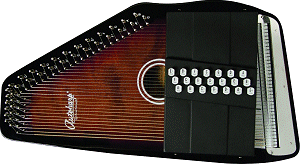
The OS21 series (sometimes with different suffixes that indicate color or electrical pickup) has been Oscar Schmidt's entry-level 21-chord line since its introduction. (Chromaharp followed suit shortly with their only 21-chorder - better built in some ways, but with far less manufacturer support.)
Fortunately for folks who like the ability to play 3-chord songs in D and A, you can play them on this harp. That probably explains why, when Oscar Scmidt introduced the first 21-Chord Appalachians, they saw fit to keep the same chord configuration as the standard 21-chorders. They did throw in an E chord bar in case you wanted to replace another chord with it, though. That would have given you the ability to play 3-chord songs in E. (As far as I understand it, they don't do this any more, though you can buy replacement chord bars from Elderly that include E, Bm, and F#m.)
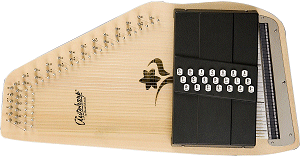 Some versions of the Appalacian replaced the round sound hole with a flower cutout but kept the standard chord arrangement. But All 21-chord Appalachians use exactly the same chord configuration as the entry-level OS21s. In other words, they're no more suitable for Bluegrass than any other 21-chord autoharp, unless you rank cosmetics way ahead of function.
Some versions of the Appalacian replaced the round sound hole with a flower cutout but kept the standard chord arrangement. But All 21-chord Appalachians use exactly the same chord configuration as the entry-level OS21s. In other words, they're no more suitable for Bluegrass than any other 21-chord autoharp, unless you rank cosmetics way ahead of function.
For that reason, when I see "Ideal for Bluegrass" in an ad for an autoharp whose only advantage over much cheaper 21-chorders is cosmetic, I can't help but feel sorry for the people who buy into such nonsense.
Better Soundboards, etc.
Some models, like the OS-100 include better sound boards - solid spruce instead of laminated. So they are louder. For that reason the OS-100 is also often labeled as "Ideal for Bluegrass." Here's something they don't want you to know - ALL electrified Oscar Schmidts sound identical through the sound system, no matter what kind of top they have. If you're going to do studio work - which always uses microphones - by all means spring for a better top. Just remember, it's no better or worse for Bluegrass or other traditional string band genres than the entry-level 21-chorders.What's Still Missing?
You may recall I mentioned 4- and 5-chord songs, which exist in bluegrass and are very common in other traditional styles, especially Folk. This includes relative minors, minor thirds, minor seconds, and secondary dominants. Okay I just scared you with some of those terms. That means that a song in Bb may use the following chords: Bb, F7, Eb, Gm, Cm, C7, and Dm. Guess what, all of those chords exist on a 21-chorder. So you're good as long as you can convince your banjo player to capo up to Bb. Oh, he's not so thrilled with that? Or you can't sing the song that high? Well in the key of G, the same chords translate to G, D7, C, Em, Am, A7, and Bm. Close but no seegar. (Bm is missing from the factory setup.)D, the favorite key of many Folk and Country guitarists even worse on autoharps - 4 and 5-chord songs in D may use D, A7, G, Bm, Am, Bm, B7, and F#m. (Bm and F#m are both missing)
In other words, if you want to play in guitar-friendly keys like D, A, and E, most autoharps lack chords you need and have chords you don't.
For more information about the chords that come standard on currently-made new Autoharps, check out our article Autoharp Factory Tunings.
Another Nod to Guitar-Friendly Keys
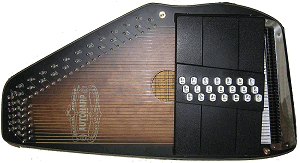 After literally decades of musicians from string-band genres begging Oscar Schmidt for autoharps they didn't have to reconfigure manually to get the chords they needed, OS finally issued an autoharp called the Americana, which leaves off Ab, Bb7, and Cm and adds E, Bm, and F#m. The Americana also switched to a chord layout method recommended by master autoharp player Bryan Bowers, putting the root chords in the middle row and moving the seventh chords to the top row.
After literally decades of musicians from string-band genres begging Oscar Schmidt for autoharps they didn't have to reconfigure manually to get the chords they needed, OS finally issued an autoharp called the Americana, which leaves off Ab, Bb7, and Cm and adds E, Bm, and F#m. The Americana also switched to a chord layout method recommended by master autoharp player Bryan Bowers, putting the root chords in the middle row and moving the seventh chords to the top row.
Personally, I think this would be the ONLY commercially-made autoharp since the Model 6 that deserves the label "Ideal for Bluegrass." Though it would be even more ideal if you replaced a couple chords you'll probably never use (maybe F7 and C7) with F#7 and C#m. That would give you the ability to play most songs in E as well as A and D.
If you price an Americana, you learn quickly that you can pay a lot for one. But don't despair - if you have ANY 21-chord autoharp you can reconfigure the chord bars yourself. In fact, Elderly Music, in Michigan, offers replacement chord bars to simplify the process.
Many tips for this and similar conversion are provided in our article "Making Your Autoharp Folk- and Bluegrass-Friendly."
Conclusion
Once again, I still have a bunch of autoharps in my workbench queue, so I may discover somehing else that has been overlooked so far. But I wanted to publish the results of this research as soon as possible, because I've already been getting questions about it. If I learn that I've published anything wrong, I'll fix it, but some of these topics don't seem to be addressed anywhere on the Internet yet - at least before I address them; then a host of similar articles start appearing. Don't ask.If you're interested in the possibility of playing an Autoharp in string-band-influenced music ("Mountain," Bluegrass, Folk, etc), the following articles might be helpful
In the meantime, please contact us with any questions at all - reader questions are the main thing that drivers our research, so we're always happy to hear from you.
Best of luck!
 Whatever else you get out of our pages, I hope you enjoy your music and figure out how to make enjoyable music for those around you as well.
Whatever else you get out of our pages, I hope you enjoy your music and figure out how to make enjoyable music for those around you as well.
And please stay in touch!
- Paul
![]()
![]()
![]()


![]()
![]()
![]()
![]()
http://CreekDontRise.com
http://SchoolOfTheRock.com
http://classictrainsongs.com
All materials, illustrations, and content on this web page are copyrighted (c) 2016 by Paul D. Race. All rights reserved.
Creek Dont' Rise(tm) is a participant in the Amazon Services LLC Associates Program, an affiliate advertising
program designed to provide a means for sites to earn advertising fees by advertising and linking to Amazon.com.
For questions, comments, suggestions, trouble reports, etc. about this page or this site, please contact us.
| Visit our other pages: | |||||
| - Music - | |||||

|
 |
 |

|

|

|

|

|

|

|

|

|

|

|

|

|

|

|
| - Trains and Hobbies - | |||||
 |

|

|  |
 |

|
| - Christmas Memories and Collectibles - | |||||
 |

|
 |

|
 |

|
| - Family Activities and Crafts - | |||||
 |

|

|

|

|

|